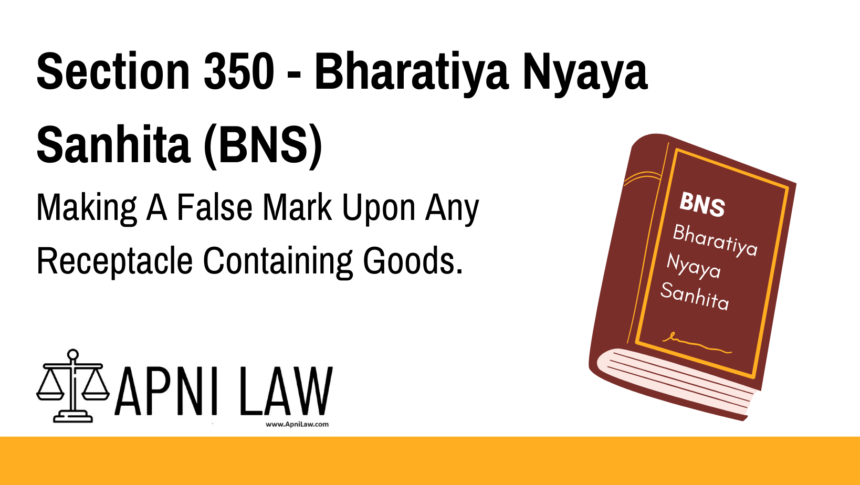Code: Section 350 BNS
(1) Whoever makes any false mark upon any case, package or other receptacle
containing goods, in a manner reasonably calculated to cause any public servant or any
other person to believe that such receptacle contains goods which it does not contain or that
it does not contain goods which it does contain, or that the goods contained in such
receptacle are of a nature or quality different from the real nature or quality thereof, shall,
unless he proves that he acted without intent to defraud, be punished with imprisonment of
either description for a term which may extend to three years, or with fine, or with both.
(2) Whoever makes use of any false mark in any manner prohibited under sub-section (1)
shall, unless he proves that he acted without intent to defraud, be punished as if he had
committed the offence under sub-section (1).
Explanation of Section 350 BNS
Section 350 of the Bharatiya Nyaya Sanhita (BNS) deals with the offense of making false marks on goods’ receptacles. This law aims to protect consumers, businesses, and public authorities from deceptive practices related to the packaging and labeling of goods.
Key Features:
- Definition of the Offense:
- False Mark: Any mark, label, or indication placed on a case, package, or receptacle that misleads regarding the contents or quality of the goods.
- Deceptive Intent: The mark should be likely to cause someone (like a public servant or a buyer) to believe something false about the goods.
- Types of Deception Covered:
- Goods being claimed as something they are not (e.g., fake branded products).
- Goods being hidden when they are actually present.
- Misrepresenting the quality or nature of the goods.
- Punishment:
- Imprisonment up to 3 years, a fine, or both.
- Burden of Proof:
- The accused must prove they acted without intent to defraud to avoid punishment.
- Use of False Mark:
- Even if the mark was not directly made but used, the offender can still be punished under the same section.
Illustration
Example 1: Fake Brand Packaging
A company labels cheap electronic gadgets with a high-end brand’s logo to sell them at a premium price. This misleads customers about the product’s authenticity and quality. If proven, this is an offense under Section 350.
Example 2: Misleading Package Contents
A trader fills a box labeled “Premium Coffee Beans” with regular, low-quality beans. The intent is to deceive buyers into paying more. This action falls under the scope of Section 350.
Common Questions and Answers on Section 350 BNS
1. What qualifies as a false mark?
- Answer: Any label, logo, or indication that misleads about the goods’ identity, contents, or quality.
2. Is it an offense if I unintentionally make a false mark?
- Answer: Yes, but you can avoid punishment if you prove you acted without any intent to defraud.
3. Who can be punished under this section?
- Answer: Anyone involved in creating, using, or benefiting from the false mark—whether manufacturers, sellers, or distributors.
4. Can I be punished if I didn’t directly make the mark but used the product?
- Answer: Yes, if you knowingly used a product with a false mark, you can be punished under this section.
Conclusion
Section 350 of the Bharatiya Nyaya Sanhita (BNS) is crucial for maintaining honesty in the marketplace. It ensures that businesses cannot deceive customers or public officials through false labeling, thereby fostering trust in commercial transactions.








